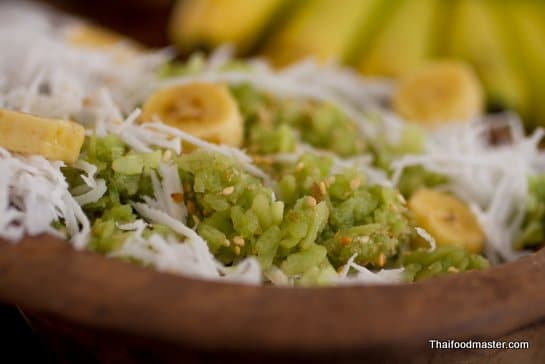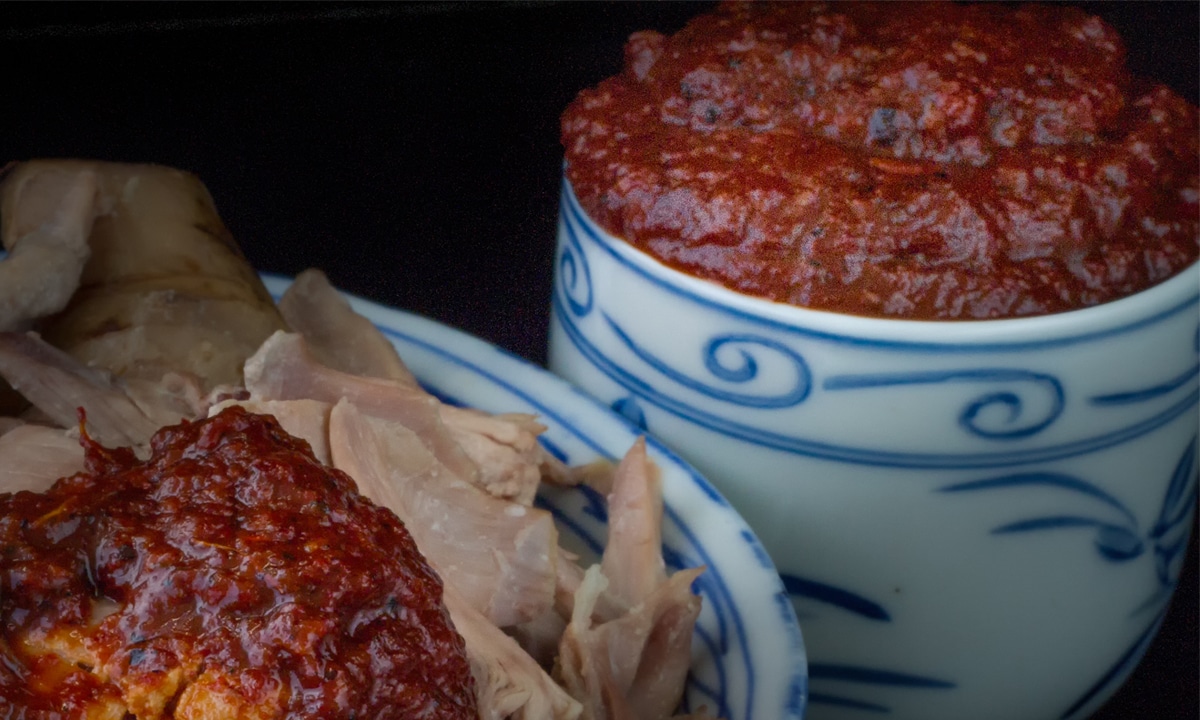Current Status
Price
Get Started

Article
In this class, part of the basic skills collection, We will learn how to grill fermented shrimp paste (kapi) in banana leaves and discuss the benefits of grilling it.
Class Content
Spicy Salad of Grilled Tiger Prawns, Mackerel, Lemongrass and Aromatics with Infused Fermented Fish Innards Dressing (ไตปลาทรงเครื่อง ; dtai bpla sohng khreuuang)

If we could strip away the spices, the seasonings, the vegetables and the herbs from savory dishes we could uncover their naked flavor profile core. There, we would encounter a strong savory-umami, sometimes coupled with other basic elements of smoke and fat. This flavor core is, for us humans, the sought-after taste of protein; our first sip of mother’s milk, and the primal experience of burned game meat on the fire.
Today we would like to highlight a powerhouse for umami creation: the fermentation process. We will focus on fermented fish innards from southern Thailand (dtai bpla ไตปลา), one of about a dozen fermented products used in the country. We will show you how chefs for the capital’s elite, as early as or, before the reign of King Phra Phutthaloetla Naphalai (Rama II, 1767-1824), harnessed its wild nature and created a dish similar to what we present today – a salad with infused fermented fish innards dressing.
Naam Phrik Lohng Reuua (Boat Embarking Chili Relish), Relish of Fermented Shrimp Paste Relsih with Sweet Pork and Crispy Deep-Fried Fluffy Fish – (น้ำพริกลงเรือต้นตำรับ ; naam phrik lohng reuua)

Naam phrik lohng reuua (น้ำพริกลงเรือ) – Literally translated as “boat embarking chili relish”, this particular boat seems to have drifted a long way from port and these days, the actual dish served in Thai restaurants is far away from the original version. We want to tell you the real story behind this dish and to present you with the original version’s recipe in its true character – as if the boat is still moored at the dock.
Khaao bping – grilled banana leaf parcels filled with fermented shrimp paste relish seasoned rice, sweet pork, and crispy garlic (ข้าวปิ้ง อย่างพระวิมาดาเธอ หม่อมเจ้าสาย ลดาวัลย์)

Khaao bping (ข้าวปิ้ง) is a dish of seasoned rice mixed with sweet pork and crispy fried garlic, then wrapped in banana leaves and grilled. Unwrapping the parcel reveals a slightly charred rice cake that melts into a pleasantly chewy, smoky, and deliciously savory treat. Created by using basic ingredients of Siamese cuisine, the dish can be served on a bed of banana leaves or on fine porcelain plates, thus touching the hearts of diners from all walks of life.
Khanohm Jeen Naam Ngiaao – Shan-Style Tomato Broth over Fermented Rice Noodles with Pork, Chicken Feet and Chicken Blood Cakes (ขนมจีนน้ำเงี้ยว)

A popular noodle dish originating from the Northern region of the Kingdom, khanohm jeen naam ngiaao (ขนมจีนน้ำเงี้ยว) is characterized by its light – yet profound – multi-layered broth. This hearty broth includes an assortment of proteins braised with the dried pollens of cotton tree flowers, and Northern Thai sour cherry tomatoes (มะเขือส้ม); the tomatoes infuse the broth with a subtle tartness that refreshes a full-bodied profile comprising a multitude of fermented ingredients.
The naam ngiaao broth is served over fermented rice noodles and features minced pork, and braised baby back pork ribs with their tender meat clinging to the bone. As well, there are succulent, slow-cooked whole chicken feet, and cubes of slightly bouncy, mauve-hued chicken blood cakes. Served alongside the soup are various toppings, which can include shredded cabbage, bean sprouts, chopped coriander leaves, and spring onions, while dark red chili oil and glossy, charred-fried dried bird’s eye chilies offer a fiery intensity dialed up to your preferred spiciness. In addition, I like to add wok-smoked sour cherry tomatoes and broom-like, crispy-fried dried cotton tree pollen for a surprising textural contrast.
Though the dish is often described as “Shan style”, the word ‘ngiao’ was a derogatory expression for the Shan people. As the disparaging – and outdated – label suggests, the recipe might reflect societal biases and prejudices; thus, at least from the culinary perspective, the ‘ngiao’ in the name of the dish may simply be a nod to the flavors or ingredients favored by The Shan, rather than a claim of authenticity – which could also explain why the dish is based on a Siamese curry paste.
Chef Thapakorn Lertviriyavit (Gorn) brings us a rare perfumed and colorful starter [salad] dish that was rediscovered in a cookbook written by a former governor of Nakhon Ratchasima (พระยานครราชเสนี – สหัด สิงหเสนี), which contained a recipe that called for rose petals, called ‘Yum Gularb’ or ‘Rose Petal Salad’. But I’d prefer to rename it, ‘Yum Gleep Kuppatchka’. You will soon understand why….

















